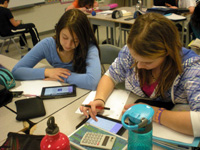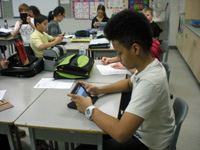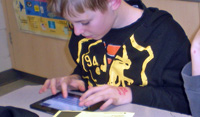 Stephanie Thompson
Stephanie Thompson
Moving students to read “outside their comfort zones, beyond fiction to texts of all kinds, while increasing motivation and engagement in learning” are goals of many teachers. Topping that off with the question, “How can I use digital texts to critically engage learners to become socially and globally conscious of the plight of others in the world?” deepens the challenge. Stephanie Thompson, the 2013 winner of the International Reading Association (IRA) Award for Technology and Reading, accomplishes these goals and more while enriching the literacy experiences of her intermediate students. Her work exemplifies innovative ways teachers use social networking systems, mobile devices, and multiliteracies to motivate today’s students.
Through creatively designed literature circles coupled with digital literacy centers, her classes' learning experiences balance reading, writing, speaking, listening, viewing, and representing through various forms of reading print and digital texts online. Embedded are important digital literacy skills students need to participate in a global society.
 Critiquing and Discussing
Critiquing and Discussing
Print and Digital Texts
 Becoming Questioners and
Becoming Questioners and
Producers of Technology  Using Mobile Devices to
Using Mobile Devices to
Explore a Topic Each experience focuses on a topic or critical issue relevant to adolescents. Topics have ranged from the impact of war on children around the world, with a special emphasis on child soldiers, to media’s impact on body image that often results in low self-esteem, health problems, and eating disorders. Importantly, students control how to approach a topic, manage learning, communicate understandings, and connect with others beyond the classrooms using the class Ning or blog.
Using mobile devices at digital literacy centers, students navigate to YouTube, podcasts, and web-based videos to gather information, data, analyze, and evaluate a topic. Learning is demonstrated through culminating projects that engage others to foster change. Past projects have included digital stories, essays, digital poetry, graphic novellas, digital docudramas, and music videos designed using PhotoStory, MovieMaker, Animator DV, Xtranormal, ComicLife, Bitstrips, Glogster, Wordle, and Scrapblog. One specific topic centered on controversial advertisements and commercials with embedded hegemonic messages. Students critically analyzed these messages through a discussion forum. Then, students gathered data and information at digital literacy centers before creating e-magazines to promote positive body images, self-expressions, identifies, and healthy living. During the topic War on Children students shared their learning at a school assembly to raise awareness about the impact of war on children around the world. They also raised and donated money to rescue Child Soldiers through War Child Canada.
Stephanie truly exemplifies ways digital experiences support her important teaching and learning goals to “prepare youth to become responsible, productive citizens” while tapping “into the digital media that is so much a part of their lives outside of school.”
Read more about Stephanie, learn more about TILE-SIG, and apply for next year’s IRA Award for Technology and Reading online.
 Tammy Ryan is from Jacksonville University, Jacksonville, Florida.
Tammy Ryan is from Jacksonville University, Jacksonville, Florida.
This article is part of a series from the International Reading Association Technology in Literacy Education Special Interest Group (TILE-SIG).